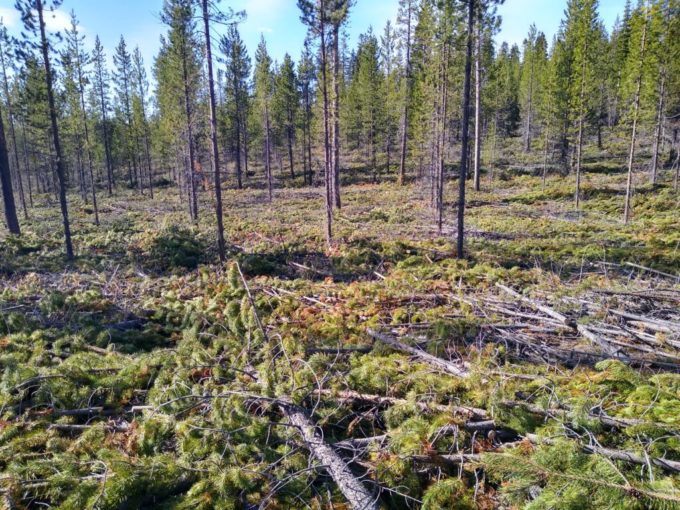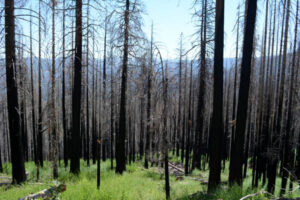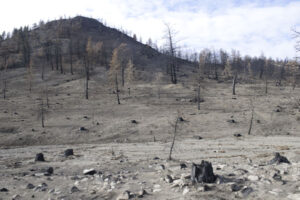
Thinning is often justified on the assumption that reducing “fuels” will slow or stop large blazes, but there is more nuance to the issue than just fuels. Photo George Wuerthner.
One frequently hears from proponents of thinning that active forest management can reduce fire intensity and thus is a beneficial policy to reduce large blazes. However, most of the scientific support for thinning is based on modeling of fuel loading, not real-life experiences. For instance, a recent LTE in the Missoulian made such a claim. The amount of fuel is often the least important factor in fire spread.
First, what drives large fires is drought, low humidity, high temperatures, and lastly, and most importantly is wind. Wind’s effect on wildfire spread is not linear but exponential. A 20 mph wind does not double fire spread over a 10 mph wind but quadruples it. One can imagine how rapidly a blaze spreads when winds are blowing 50-70 mph, as often is the case when large acreages burn.
Now imagine what happens when a forest stand is thinned. The forest is opened up to greater wind penetration, and the wind is the most crucial factor in wildfire spread. Thinning also results in more fine fuels on the ground that will carry a fire. And opening up the canopy allows greater solar penetration meaning fuels and soils dry out quicker.
Another often overlooked consequence of thinning is that it often removes larger trees. What burns in a forest fire is primarily “fine fuels” like grass, shrubs, and small trees.

Larger trees seldom burn up in a forest fire, and thus removal of larger trees in the name of “fuel reduction” has little effect on fires. The snag forests that result from large blazes are very important to wildlife. Photo George Wuerthner.
The larger trees are relatively fire-resistant, which is why you get snags remaining even after a high severity blaze. As is often the case in Forest Service “thinning projects,” remove the larger trees which provides little benefit.
For these reasons, some studies have demonstrated that thinned stands are often more likely to spread wildfires.
A review of 1500 wildfires in dry and mixed conifer forests, the very forests that supposedly have excess fuel buildup, found that stands with “active forest management, burned at higher severity than forests in protected areas like parks and wilderness where presumably there is more fuel.
Finally, even if thinning worked to slow blazes under ordinary fire weather conditions, under the extreme conditions that drive all large wildfires, the wind effectively negates thinning benefits by blowing embers miles ahead of a fire front. Thus, embers are tossed over, through, and around any fuel breaks or thinned stands.

A fifty mph wind drove a blaze through a recently thinned stand near Helena, Montana. Photo George Wuerthner.
Add to all these factors is the very low probability that any thinned forest stand will encounter a fire. The likelihood is around 1-2%.
The majority of thinned areas are never burned during the period when they “might” be somewhat effective. Keep in mind that thinning by reducing competition for water and sun promotes the rapid growth of more fine fuels—so in 5-10 years, you have more grass, shrubs, small trees, which are the very things that burn readily in a forest fire.
A review of 1500 wildfires in dry and mixed conifer forests, the very forests that supposedly have excess fuel buildup, found that stands with “active forest management’, burned at higher severity than forests in protected areas like parks and wilderness where presumably there is more fuel.
The majority of acreage charred by wildfire occurs in ecosystems where unnatural fuel “build up” has not happened due to the naturally long fire rotations in these landscapes. These vegetation types include sagebrush, chaparral, juniper, fir forests, lodgepole pine, aspen, and other higher elevation forests.
However, thinning is not benign. Thinning removes carbon stored in trees. The disturbance from logging roads and activities spreads weeds, including cheatgrass, which is highly flammable. Logging can displace sensitive wildlife like elk. Sediment from logging roads can fill streams harming aquatic life.
So we trade inevitable negative consequences of active forest management (thinning) today and get only a tiny chance that any thinning will influence a wildfire.